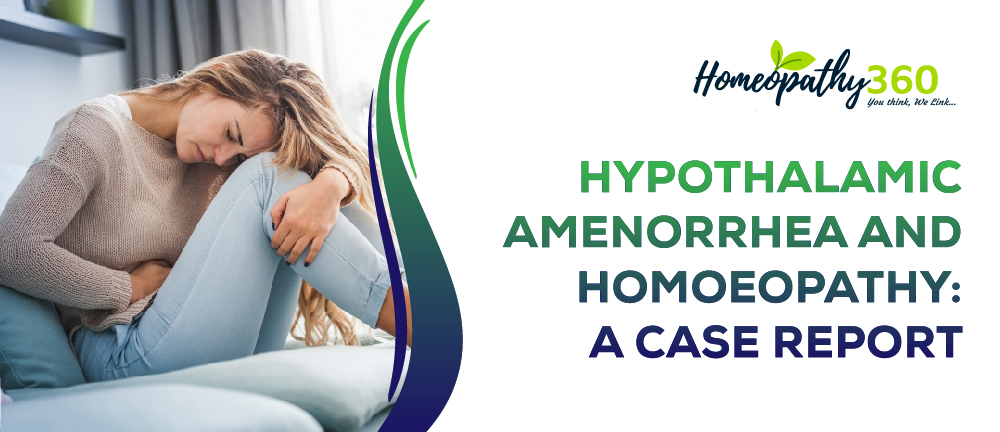
Abstract: A female patient came with a complaint of amenorrhoea. Her menses got suppressed suddenly on the third days of her menses. After analysis, evaluation and repertorisation she was prescribed Natrum muriaticum 200 which has proved its efficacy in resolving a case of hypothalamic origin.
Keywords: secondary functional hypothalamic amenorrhoea, hypothalamic-pituitary-ovarian axis, Natrum muriaticum, homoeopathy.
Abbreviations: ICD- International Classification of Diseases.
INTRODUCTION
This case is a classic example of secondary functional hypothalamic amenorrhoea which in this case was a result of getting sudden unexpected stress. In a previous regularly menstruating woman, amenorrhoea can be defined as the absence of menses for three months while in a woman with previous history of irregular menstruation, absence of menses for six months can be defined as amenorrhoea. Amenorrhoea can be classified as primary and secondary based upon the past history of absence or presence of established menarche respectively.
Functional hypothalamic amenorrhoea results from the suppression of hypothalamic-pituitary-ovarian axis due to an energy deficit state which can be produced by stress, weight loss, (independent of original weight), too much of exercise, or disordered eating. In this disorder, no structural or organic changes are found in the hypothalamic-pituitary-ovarian axis and is characterized by low levels of oestrogen.[1] This case shows us its successful management through homoeopathy.
CASE HISTORY
Chief complaints
A female aged 22 years reported with the complaint of amenorrhoea since 4 months.
History of presenting illness
Patient was apparently well 5 months back when her menstrual flow was ceased on the 3rd day of her menstrual cycle. According to the patient, she was in a temple when she got a call from her lover and had an argument which was not expected by her. After coming back to her residence she found that her menstrual flow was very scanty as compared to the previous cycles. On the 4th day of her menses, the flow ceased completely. After that day, her menses didn’t appeared even after 3 months of her last menstrual period. Previously, she used to have regular menstrual cycle of 30 days and the flow used to remain for seven days. Her last menses appeared on12-09-2020. There was no history of dysmenorrhoea or any other associated complaints during her menstrual cycle. She got her menarche at 13 years of age.
Sexual history
There was no history of sexual contact.
Past history
The patient got affected with taenia cruris 1 year back for which she took allopathic treatment.
Family history
There was a family history type-II diabetes mellitus to her mother and hypercholestraemia in her father.
Physical generals
Patient’sappetite was normal. There was thirstfor 2-3 L of water per day even during winters (thirsty in general). She has a desire for salty food. (++) There were no specific aversions to any food. Urine frequency was 5-6 times/day and there were no associated urinary complaints. Stool frequency was 1 time/day. There were satisfactory and regular bowel motions. Patient slept for 7-8 hours and had a refreshing sleep.The patient didn’t remember her dreams. Perspirationoccurred more on palms and soles which is non-offensive and didn’t stain the linen. Thermally, the patient was hot.(+++)
Physical examination
Weight: 60 kg
Height: 161.5 cm
BMI: 23
Thyroid palpation: Not palpable
Sexual maturity rating: Grade V
Acne: Absent
Hirsutism: Absent
Webbed neck: Absent
Low hairline: Absent
Laboratory investigation: Ultrasonography of pelvis was done which gave normal findings (Figure 1)
Mind
Patient became lachrymose while telling about her fight with her lover but didn’t shed off the tears. She weeps when alone and feels better after weeping.++ Patient has a tendency to weep during anger.++ She has a reserved nature, as she keeps her things to herself only and do not share with anyone.++ She desires to stay alone and don’t want to get involved with friends.++Patient was absorbed in her thoughts throughout the case taking process while being questioned.
DIAGNOSIS
After ruling out all the other possible causes of secondary amenorrhoea, it was diagnosed as the secondary functional hypothalamic amenorrhoea. This case comes under the WHO group II class of amenorrhoea[2] and has been coded as N91.1 under ICD-10 CM classification.[3]
CASE ANALYSIS
Analysis and evaluation of symptoms
Given in table 1.
Repertorial totality
Synthesis 9.0 repertory was used for repertorisation[4].
- Mind, ailments from, love, disappointed
- Mind, company, aversion to
- Mind, reserved
- Mind, weeping, alone, when
- Mind, weeping, anger, during
- Female genitalia/sex, menses, suppressed, disappointed love from
- Extremities, perspiration, foot, sole
- Extremities, perspiration, hand, palm
- Generals, food and drinks, salt, desire
REPERTORIAL CHART
Shown in figure 2.
THE REMEDY
Repertorial result shows Natrum muriaticum as the prominent remedy which covers all the symptoms presented by the patient. After corroboration with the knowledge of materia medica, Natrium muriaticum 200C/ 1 dose was prescribed to the patient.
200C potency was selected according to the susceptibility of patient. Susceptibility of the patient was increased due to disturbed mental and physical state of the patient. The patient belongs to middle age group and has a moderate level of physical exertion and so was her susceptibility. So, moderate potency was selected[5].
FOLLOW-UP
First prescription- Natrum muriaticum 200C/1 dose, dated- 18/01/2021
1. 25/01/2021: Menses appeared on 24/01/2021 with normal flow and remained for 6 days. No other complaints were reported.
Prescription: Placebo 30 twice a day for 30 days.
2. 29/02/2021: Menses appeared on 22/02/2021, normal flow, remained for 6 days. A thyroid profile was conducted on 23/02/2021 to rule out any thyroid abnormality. The report is shown in figure 3 and has shown normal values. No other complaints were reported.
Prescription: Placebo 30 twice a day for 30 days..
3. 31/03/2021: LMP- 18/03/2021, normal flow remained for 6 days. No other complaints were reported.
Prescription: Placebo 30 twice a day for 30 days..
CONCLUSION
The main drawback in this case was that we didn’t have the laboratory investigations of patient’s hormonal assays. But the strength is that all the possibilities of other pathologies were excluded clinically.
From this case, it can be concluded that secondary functional hypothalamic amenorrhoea can be successfully treated with homoeopathy. This case shows the importance of causative factors in the selection of medicine. It also shows that if the medicine is selected on the basis of a complete picture of the case, a single dose is able to give the optimum results. It further proves the efficacy of materia medica and repertorial results. This case corroborates with the teachings of psycho-somatic disorders given by Dr Hahnemann in his book Organon of Medicine. It also shows the efficacy of Natrum muriaticum in cases of hypothalamic dysfunction and further researches can be done in this aspect to explore and enlighten the literature of homoeopathic medicines in terms of modern science.
REFERENCES
1. Klein D, Poth M. Amenorrhoea: An Approach to Diagnosis and Management [Internet]. American Family Physician; 2013 [cited 18 February 2021]. Available from: https://www.aafp.org/afp/2013/0601/afp20130601p781.pdf
2. Berek J. Berek & Novak’s Gynaecology. 15th ed. New Delhi: Wolters Kluwer India Pvt Ltd; 2016.
3. Icd10data.com. 2021. Search Page 1/1: Amenorrhoea. [online] Available at: https://www.icd10data.com/search?s=Amenorrhoea> [Accessed 19 February 2021].
4. RADAR Version 10.0
5. Close S. The genius of homoeopathy Lectures and Essays on Homoeopathic Philosophy. New Delhi: B. Jain Publishers (P) LTD.; 2015.





